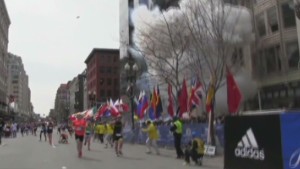Boston Marathon bombs have hallmarks of 'lone wolf' devices, experts say
April 17, 2013 -- Updated 0257 GMT (1057 HKT)

New clues in Boston Marathon attack
STORY HIGHLIGHTS
- Boston Marathon bombs seem to follow widely available recipe, experts say
- "Lone wolf" devices worry the intelligence community because there's "no trail, no intelligence"
- Al Qaeda, U.S. right-wing extremists use hard-to-trace bombs, experts say
In this case, the formula
seems very similar to one that al Qaeda has recommended to its
supporters around the world as both crudely effective and difficult to
trace. But it is also a recipe that has been adopted by extreme
right-wing individuals in the United States.
The threat of the "lone wolf" alarms the intelligence community.
"This is what you worry
about the most," a source with knowledge of the investigation told CNN's
Chief Political Analyst Gloria Borger. "No trail, no intelligence."
 Bombing investigation could take time
Bombing investigation could take time
 Images show bomb fragments from attack
Images show bomb fragments from attack
 How Americans responds to evil
How Americans responds to evil
Officials have told CNN
that among the materials used in the attack on the marathon were some
sort of timing device, a basic mixture of explosives and some sort of
metal container containing nails and other projectiles. The FBI said
late Tuesday that what appeared to be fragments of ball bearings, or
BBs, and nails had been recovered and had possibly been contained in a
pressure cooker.
One federal law
enforcement source told CNN's Deborah Feyerick the devices contained
"low-velocity improvised explosive mixture -- perhaps flash-powder or
sugar chlorate mixture likely packed with nails or shrapnel."
An explosives expert told
CNN the yellowness of the flame probably came from carbon or some
organic fuel such as sugar that contains it. The expert, who is
frequently consulted by the FBI and other government agencies, said the
white smoke made it "unlikely that a military-grade high explosive, such
as those used in shells and bombs, which is usually grey or black, was
used."
U.S. Rep. Mike McCaul, chairman of the House Homeland Security Committee, said "most likely gun powder" was used in the devices.
Such improvised devices
use readily available materials that cannot be easily traced. Al Qaeda
in the Arabian Peninsula, in its English-language online magazine
Inspire, noted such "ingredients are readily available" and they are
"easily disposed of if the enemy searches your home."
There is no evidence
that AQAP or any of its supporters was involved in the Boston attack.
Nor is it clear whether the attack was the work of one or more
individuals. But AQAP has championed 'do-it-yourself terrorism' in the
last three years, urging Muslims in the West to take action on their
own.
"How to Make a Bomb in
Your Mom's Kitchen," published in a 2010 edition of Inspire, has been
downloaded by Islamist militants plotting terrorist attacks in both the
United States and the U.K., according to counterterrorism officials.
Eight pages were devoted
to building a basic but lethal device. The ingredients included sugar
and a black powder made from match heads. Combining step-by-step
instructions and diagrams, the magazine described wiring a "timed
circuit as it is simple" and using small nails as shrapnel. It said
gunpowder or powder from fireworks can be used as a substitute for match
heads.
It continues: "It only
works if contained in a high-pressure environment. So you may use iron
pipes, pressure cookers, fire extinguishers or empty propane canisters
... The pressure cooker is the most effective method."
The U.S. Department of
Homeland Security has issued several unclassified bulletins about the
use of pressure cookers as part of an explosive device. In July 2010,
the DHS said that while pressure cookers are common in countries such as
Afghanistan, "the presence of a pressure cooker in an unusual location
such as a building lobby or busy street corner should be treated as
suspicious."
Such a formula is
certainly not unique to AQAP. Variations appear all over the Internet. A
senior U.S. counterterrorism investigator told CNN that pressure cooker
bombs have also been a signature of extreme right-wing individuals in
the United States who he said tend to revel in building homemade bombs.
For example, the devices
planted by Erich Rudolph at an Atlanta park during the 1996 Olympic
Games were pipe bombs filled with gunpowder and nails to increase their
lethality; it also had an alarm clock as a timing mechanism. Like the
bombings in Boston, those devices were concealed in a backpack,
according to a Department of Homeland Security report detailing the 1996
attack.
At least two previous
terrorist plots on U.S. soil have involved variations on the Inspire
recipe, and both involved "lone wolves." Pakistani-American Faisal
Shahzad tried to detonate a vehicle bomb in Times Square in 2010 that
included "a pressure cooker containing approximately 120 firecrackers,"
according to the 2010 DHS bulletin.
The indictment against
another alleged "lone wolf" militant, Jose Pimentel, described a video
"showing the defendant following precisely the instructions from the
Inspire Magazine article by (i) scraping the heads from the matches and
collecting the incendiary powder in a bowl; and (ii) connecting a
Christmas tree light to the battery using wiring to create an ignition
device."
Pimentel was arrested by
New York police in November 2011 and pleaded not guilty to state
terrorism charges. He had not received training overseas, but Shahzad
had received training from a bomb-maker with the Pakistani Taliban.
And exactly one year
before Pimentel's arrest, Taimur Abdulwahab al-Abdaly flew to Sweden
from England. There he built a powerful but rudimentary bomb, using
ingredients he was able to purchase locally: pressure cookers,
fireworks, explosive chemicals, and nails and ball bearings. He too had
received bomb-making training, not in Pakistan, like many others, but in
Iraq.
Abdulwahab died when he tried to detonate a device in central Stockholm in December 2010.

ไม่มีความคิดเห็น:
แสดงความคิดเห็น